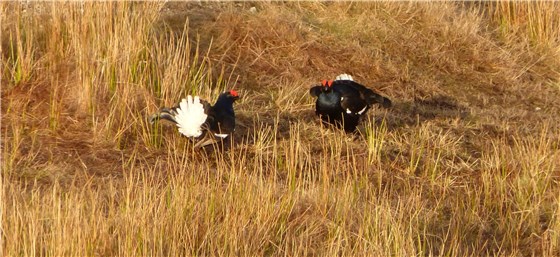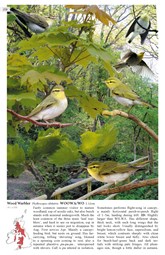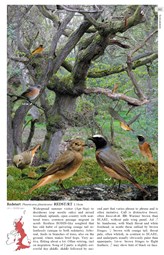Crossley ID Guide Britain and Ireland
A revolutionary new field guide: The Crossley ID Guide Britain and Ireland

A new and very different type of field guide, well worth a look.
A look at our book shelves reveals a lot of bird books, mostly field guides, that help us identify all those amazing birds we are lucky enough to encounter. A look at the books themselves shows a very similar layout and design despite the large number, variety of countries covered and range of publishers. It seems that field guides are stuck in a bit of rut, albeit a very useful rut!
So when we were asked by Princeton University Press to review The Crossley ID Guide we were surprised by its new approach to a field guide. Don't be put off by the cover which is, well, a little twee to be honest. Is this how America sees the UK? So quickly open the book and take a quick flick through, we think you will be surprised, very surprised!

The Chough is one of the many star birds in North Wales.
Most people will stop at a species that has some significance for them. The Chough breeds on the Great Orme in North Wales, which is just above our house, so it's a very special bird for us. Looking at the plates you may be a bit taken aback by the sheer number of images for each species. There are twenty-five photographs of Chough in all sorts of poses in just the one picture: perched, in flight, feeding and preening. Take some time to take in all the birds on the busy page - the birds are all depicted against a photograph of their habitat, which add a "real" feel to the birds.
But the big question is, does the book help you identify the bird you have just seen? In our opinion, the answer is very big yes! The fact the birds are shown as photographs rather than illustrations gives a realistic look to the birds as you would encounter them in the field. The number of pictures, although a little overwhelming at first, provide a wonderful aid to identifying a bird you have just seen. How many times do you see a bird posed facing left on a white back ground just as they're always depicted in traditional field guides? This is the strength of this new guide: the birds are shown as you see really them in the field.

A Spring dawn on the moors is a magical experience.
If we had to pick one favourite bird here in North Wales it would be the Black Grouse. The pictures in the Crossley Guide really give a feel for this wonderful bird and importantly the habitat in which you may be lucky enough to see one of these amazing birds. It would have been good to have seen a picture of a male in full display, the way many birders see their first Black Grouse here in North Wales.

Here's a picture of Black Grouse lekking taken on one of our popular tours.

The oak woodlands provide home for Pied Flycatchers.
North Wales also has some very special birds that arrive in our woodlands in the Spring and they can be a little tricky to see as they move through the canopy. It is with this type of species, flycatchers, warblers and redstarts, that a field guide is really tested to its limits. A small bird catches your eye moving through the leaves above, you only have brief views from a variety of angles and build up a "jigsaw" image of the bird in your mind. You see the tail, a wing, maybe a glimpse of the head, not easy to put a name to the whole bird. Now turn to your new Crossley ID Guide and we think you will have a real help at hand: the photos look exactly like what you have just been watching! The idea of setting the birds in their habitat in this way really adds to this realistic feel.

The song of Wood Warblers rings through the canopy.
Of course there is more to the guide than the plates as concise text and a distribution map accompanies each of the plates. The text and map are a little squashed in but this is to allow the plates to be of a size to be clear and useful, while making the guide still easily portable - vital for a field guide. The species are listed, not in taxonomic order but grouped with similar species which aids the identification process. A quick key at the front shows where each bird can be found and it is very easy to locate birds given a little practice and familiarity with the system. An introduction clearly explains how to get the best from the book. This is then followed by a section on "How to be a better birder" - interesting that the book uses the term 'birder' rather than 'birdwatcher', a good move we think. This section is written in a very informal and accessible style that makes you smile at times but more importantly makes you think a little differently about the way we look at birds. Then comes a very clear explanation of bird topography using photographs again, rather than a drawing, which all make the whole section easier to understand and well worth studying.

A flash of colour anounces the appearance of a Redstart.
Richard Crossley and Dominic Couzens have lifted the field guide out of the rut and produced a first class book that is well worth looking at. It won't be to everyone's taste - what book ever is - but we think it is a very worthwhile addition to every birder or birdwatcher's bookshelf and more importantly to your backpack when heading out into the field!
This review is part of the Crossley Blog Tour, so to find more reviews and articles please follow the links to other bloggers starting with tomorrow's guest blog
http://10000birds.com/category/birdsFor a chance to win a signed copy of this fantastic book please visit:
http://blog.press.princeton.edu/crossley-id-guide-uk-giveawayIf you wish to see a list of contributing bloggers please visit:
http://blog.press.princeton.edu/crossley-uk-blog-tour-scheduleFinally, if you have any questions for either Richard Crossley and Dominic Couzens then they are holding a live video call on November 21st on:
http://shindig.com/event/crossley-id-guideMany thanks for reading this and we hope you have enjoyed our review. If you fancy putting the book to the test then why don’t you book a day trip with Alan and Ruth of The Biggest Twitch, we look forward to meeting you. Email us for details on:
info@thebiggesttwitch.comThe Crossley ID Guide
Britain and Ireland
Paper flexibound. £16.95. ISBN:9780691151946
304 pages. 300+ colour plates. 250 maps.